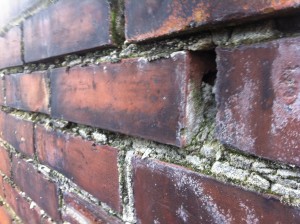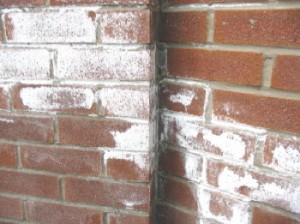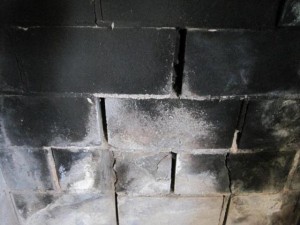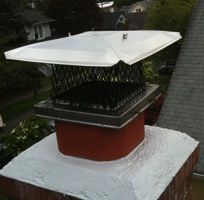Many Seattle homeowners are under the impression a simple chimney sweep is all they need to get their fireplace up and running. Yes, your certified chimney sweep should be performing a detailed inspection of all the vital components of the fireplace interior and make chimney repair recommendations to the exterior. What if you are the homeowner who doesn’t use their fireplace? Or maybe you have switched to a gas insert so you no longer require and annual chimney sweep, how do you know if you need chimney repair. Here are 5 things you can check on your own to determine the state of your masonry chimney condition and structure.
1. Check for a Chimney Cap
You don’t even need a ladder for this one, step outside and take a look. The chimney cap’s #1 purpose is keeping rain out of the chimney flue. Yes, it is not a masonry portion of your chimney, but its presence is vital to the survival of your chimney’s interior and exterior. In 95% of cases needing chimney repair that I find in the Seattle and Bellevue
area, a chimney cap is not present. Why is this a problem? Water. We all know water is the #1 source of deterioration of all home components, rot, mold, mildew, moss, freeze-thaw, etc, etc. Water in your chimney, or in your masonry is always bad news. If your chimney does not have a chimney cap, its time for a chimney inspection, possibly some repair, and most definitely time to install a chimney cap.
2. Is your Chimney Crown in Good Condition?
The chimney crown is the chimney’s second line of defense against… you guessed it, water. The crown is the 2″-3″ concrete or mortar slab that has been poured on the very top of the chimney. This covers the top course of bricks of your chimney and surrounds the top flue tiles of each appliance. Why is this needed? Besides for the aesthetic appeal, chimneys are constructed with a hollow interior surrounding the flue tiles. This hollow space around your fireplace, and flue liners is very important (but will be left for another blog post). Other than covering the hollow opening of the chimney the brick also much be covered. Most bricks have a somewhat water resistant facing on their front and sides, however, on the top and bottom they are extremely porous. This is vital during brick construction so the mortar can achieve the best bond to the brick top and bottom as possible. However, when left exposed to the weather the brick becomes saturated with moisture and is exposed to freeze-thaw, moss and mildew. Wet bricks and mortar joints = deterioration. Check your chimney crown for proper construction, proper thickness, cracks or receding edges or corners. Just like chimney caps, when a chimney has an improper or damaged crown 95% of the time there is deterioration to the chimney structure, and you will need a chimney repair.
3. Do you need Chimney Tuckpointing?
 Chimney tuckpointing is commonly misused to describe “mortar joints”. “Tuckpointing” is actually a verb and describes the process of repairing mortar joints, this is a common chimney repair service and usually needs to be done on all chimney masonry every 30-50 years. So how do we know when we need our mortar repaired? Well, since chimneys are half above the roof and half below the roof, they always deteriorate at different rates. Above the roof the chimney is exposed to harsher weather conditions, colder temperatures, wind, rain, ice, snow. Below the roof the chimney is much more protected. Not to mention if the chimney is missing a cap or has a damaged crown, the damage will start at the top and slowly progress downward. Check your mortar joints above the roofline first. Check for cracks, separations between the mortar and the brick, and finally take a screwdriver and scrape the mortar to see if it is soft or begins to flake a fall away. Good mortar will barely leave a mark when running your screwdriver across it. Bad mortar will fall away and leave a gouge. Make your way down the chimney below the roofline and check the mortar there as well. Any areas where the mortar is soft should be repaired. Chimney tuckpointing can only be done to partially damaged mortar however. If the mortar joint is left unchecked for long enough it will fail completely through the joint and the bricks will be loose. Once your bricks are loose, they have to be rebuilt. Take a hammer or the palm of your hand and tap on some bricks near the top, moving down. If any of the bricks are loose, those will need to be torn down and re-mortared.
Chimney tuckpointing is commonly misused to describe “mortar joints”. “Tuckpointing” is actually a verb and describes the process of repairing mortar joints, this is a common chimney repair service and usually needs to be done on all chimney masonry every 30-50 years. So how do we know when we need our mortar repaired? Well, since chimneys are half above the roof and half below the roof, they always deteriorate at different rates. Above the roof the chimney is exposed to harsher weather conditions, colder temperatures, wind, rain, ice, snow. Below the roof the chimney is much more protected. Not to mention if the chimney is missing a cap or has a damaged crown, the damage will start at the top and slowly progress downward. Check your mortar joints above the roofline first. Check for cracks, separations between the mortar and the brick, and finally take a screwdriver and scrape the mortar to see if it is soft or begins to flake a fall away. Good mortar will barely leave a mark when running your screwdriver across it. Bad mortar will fall away and leave a gouge. Make your way down the chimney below the roofline and check the mortar there as well. Any areas where the mortar is soft should be repaired. Chimney tuckpointing can only be done to partially damaged mortar however. If the mortar joint is left unchecked for long enough it will fail completely through the joint and the bricks will be loose. Once your bricks are loose, they have to be rebuilt. Take a hammer or the palm of your hand and tap on some bricks near the top, moving down. If any of the bricks are loose, those will need to be torn down and re-mortared.
4. Do you have Efflorescence or White Staining?
 White discoloration on a chimney is a sure sign of a moisture problem and a good indicator of some possible chimney repair. This is called efflorescence, it is the natural salts in the brick and mortar that are brought to the surface by moisture and then left behind when the moisture evaporates. This can be removed easily with warm soapy water, however, this w0n’t solve the problem. The most common causes of this is a missing chimney cap, a damaged or missing crown, and/or damaged mortar joints. Let your chimney repair technician know where you are noticing the white staining on your chimney for a more accurate diagnosis.
White discoloration on a chimney is a sure sign of a moisture problem and a good indicator of some possible chimney repair. This is called efflorescence, it is the natural salts in the brick and mortar that are brought to the surface by moisture and then left behind when the moisture evaporates. This can be removed easily with warm soapy water, however, this w0n’t solve the problem. The most common causes of this is a missing chimney cap, a damaged or missing crown, and/or damaged mortar joints. Let your chimney repair technician know where you are noticing the white staining on your chimney for a more accurate diagnosis.
5. Is There Firebox Damage?
 Are there missing mortar joints in your fireplace bricks? Are the bricks loose? or covered in white efflorescence? These are very common signs of once again, water leaks into the chimney. Your fireplace firebox is constructed of a very fragile type of brick called firebrick. This type of bricks is designed to be porous to provide adequate insulation to prevent heat transfer. It also is not constructed with just plain old mortar. It requires a special refractory cement to hold the bricks together throughout the high temperatures of your open fire. This refractory cement however, is water soluble. When these firebox mortar joints get wet, they turn to powder and fall apart. Loose bricks, missing mortar joints and crumbling firebrick are all sure signs that chimney repair is in your near future.
Are there missing mortar joints in your fireplace bricks? Are the bricks loose? or covered in white efflorescence? These are very common signs of once again, water leaks into the chimney. Your fireplace firebox is constructed of a very fragile type of brick called firebrick. This type of bricks is designed to be porous to provide adequate insulation to prevent heat transfer. It also is not constructed with just plain old mortar. It requires a special refractory cement to hold the bricks together throughout the high temperatures of your open fire. This refractory cement however, is water soluble. When these firebox mortar joints get wet, they turn to powder and fall apart. Loose bricks, missing mortar joints and crumbling firebrick are all sure signs that chimney repair is in your near future.
For a complete evaluation of your chimney’s interior and exterior, along with suggestions for chimney repair or preventative chimney maintenance contact a CSIA certified chimney sweep in Seattle and book a chimney inspection appointment today. Visit our chimney inspections page for more information.
By: Aaron Woodward

